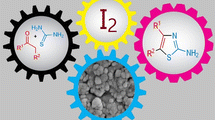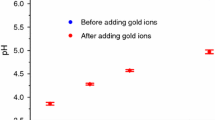Abstract
A green synthesis of size-controllable, uniform gold nanospheres is reported. The size of the gold particles can be selectively tuned from nanometer to submicrometer regimes with narrow size distribution through pH adjustment of the solution. Based on the employed green chemical reduction method, soluble starch is used as both reducing agent and stabilizer. Soluble starch is generally a very weak reducing agent. However, under an alkaline condition, its reducing efficiency is enhanced by the concomitant generation of reducing species as the starch molecules are alkaline degraded. The in situ generated reducing species nucleate and grow gold nanoparticles. The growth mechanism of gold particles is systematically investigated and proposed. The synthesized gold colloid is very stable and can be kept over 4 months without precipitation, aggregation, or any significant changes. Moreover, all processes of this method are simple and environmentally friendly, and no complex instrument is needed.

Similar content being viewed by others
References
C. L. Haynes, A. D. McFarland, and R. P. Van Duyne, Anal. Chem., 77, 338 (2005).
J. A. Seelenbinder, C. W. Brown, P. Pivarnik, and A. G. Rand, Anal. Chem., 71, 1963 (1999).
C. S. Thaxton, D. G. Georganpoulou, and C. A. Mirikin, Clin. Chim. Acta, 363,120 (2006).
D. Huang, F. Liao, S. Molesa, D. Redinger, and V. Subramanian, J. Electrochem. Soc., 150, 412 (2003).
B. Hvolbeak, T. V. W. Janssens, B. S. Clausen, H. Falsig, C. H. Christensen, and J. K. Nørskov, Nanotoday, 2, 14 (2007).
M. Sametband, I. Shweky, U. Banin, D. Mandler, and J. Almog, Chem. Commun., 1142 (2007).
J. Turkevich, P. C. Stevenson, and J. Hillier, J. Phys. Chem., 57, 670 (1953).
M. K. Corbierre, J. Beerens, and R. B. Lennox, Chem. Matter., 17, 5774 (2005).
S. Link, Z. L. Wang, and M. A. El-Sayed, J. Phys. Chem. B, 103, 3529 (1999).
Y. Sun and Y. Xia, Science, 298, 2176 (2002).
S. Guo and E. Wang, Inorg. Chem., 46, 6740 (2007).
J. A. Dahl, B. L. S. Maddux, and J. E. Hutchison, Chem. Rev., 107, 2228 (2007).
P. Raveendran, J. Fu, and S. L. Wallen, J. Am. Chem. Soc., 125, 13940 (2003).
P. Raveendran, J. Fu, and S. L. Wallen, Green Chem., 8, 34 (2006).
H. Huang and X. Yang, Biomacromolecules, 5, 2340 (2004).
Z.-M. Qi, H.-S. Zhou, N. Matsuda, I. Honma, K. Shimada, A. Takatsu, and K. Kato, J. Phys. Chem. B, 108, 7006 (2004).
N. Vigneshwaran, R. P. Nachane, R. H. Balasubramanya, and P. V. Varadarajan, Carbohydr. Res., 341, 2012 (2006).
W. Yang, Y. Ma, J. Tang, and X. Yang, Colloids Surf. A: Physicochem. Eng. Asp., 302, 628 (2007).
X. Ji, X. Song, J. Li, Y. Bai, W. Yang, and X. Peng, J. Am. Chem. Soc., 129, 13939 (2007).
H. Zhang, J.-J. Xu, and H.-Y. Chen, J. Phys. Chem. C, 112, 13886 (2008).
S. Ekgasit, N. Pattayakorn, D. Tongsakul, C. Thammacharoen, and T. Kongyou, Anal. Sci., 23, 863 (2007).
A. Usher, D. C. McPhail, and J. Brugger, Geochim. Cosmochim. Acta, 73, 3359 (2009).
S. Link and M. A. El-sayed, J. Phys. Chem. B, 103, 4212 (1999).
J. M. Krochta, J. S. Hudson, and S. J. Tillin, Am. Chem. Soc. Div. Fuel Chem., 32, 148 (1987).
O. P. Golova and N. I. Nosova, Russ. Chem. Rev., 42, 327 (1973).
D. S. Jackson, C. Choto-Owen, R. D. Waniska, and L. W. Rooney, Cereal Chem., 65, 493 (1988).
C. J. Knill and J. F. Kennedy, Carbohydr. Polym., 51, 281 (2003).
J.-A. Han and S.-T. Lim, Carbohydr. Polym., 55, 193 (2004).
R. Kizil, J. Irudayaraj, and K. Seetharaman, J. Agric. Food Chem., 50, 3912 (2002).
G. Socrates, Infrared and Raman Characteristic Group Frequencies: Tables and Charts, 3rd ed., John Wiley & Sons Ltd, Chichester, 2001.
N. R. Jana, L. Gearheart, and C. J. Murphy, Chem. Mater., 13, 2313 (2001).
Author information
Authors and Affiliations
Corresponding author
Electronic supplementary material
Rights and permissions
About this article
Cite this article
Pienpinijtham, P., Thammacharoen, C. & Ekgasit, S. Green synthesis of size controllable and uniform gold nanospheres using alkaline degradation intermediates of soluble starch as reducing agent and stabilizer. Macromol. Res. 20, 1281–1288 (2012). https://doi.org/10.1007/s13233-012-0162-7
Received:
Revised:
Accepted:
Published:
Issue Date:
DOI: https://doi.org/10.1007/s13233-012-0162-7




